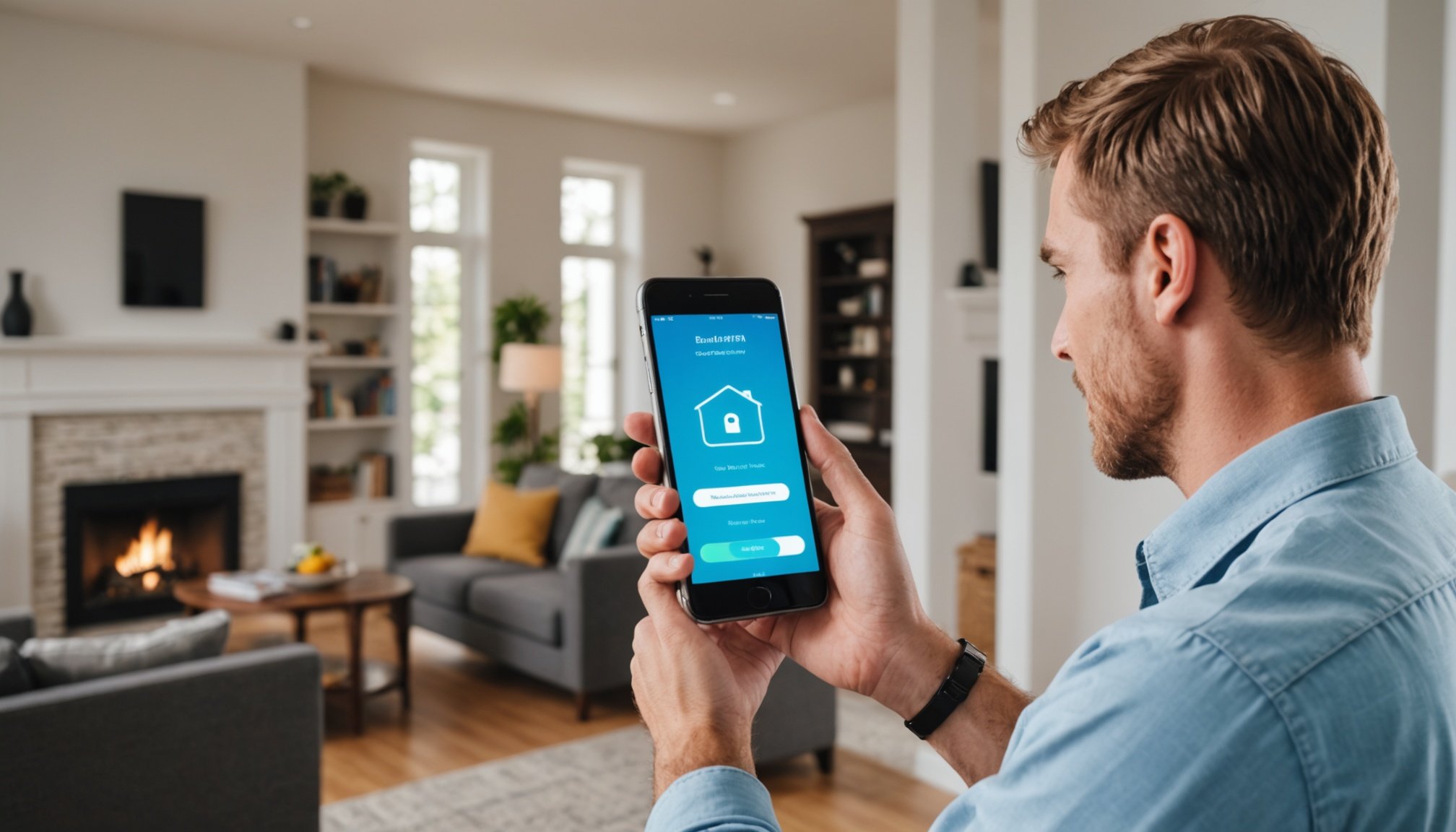Advanced Smartphone Integration Techniques
Smartphones have become a central component in modern smart home security systems, offering seamless integration that enhances overall security. By employing sophisticated smartphone integration techniques, users can easily monitor and control their home environment, even when they are miles away.
Overview of Smartphone Security Integration
The integration of smartphones with smart home technology involves connecting various security devices to a central system that is accessible via a mobile app. This integration allows homeowners to manage their security systems with ease and flexibility. Additionally, smart home technology strategies leverage the capability of smartphones to provide real-time alerts, detect unusual activity, and maintain comprehensive monitoring logs.
Also to read : Unlocking remote desktop success: essential smartphone strategies for effortless connectivity
Benefits of Smartphone Security Integration
Using smartphones for security measures provides unparalleled convenience. Homeowners can lock doors, adjust lighting, or view live camera feeds, ensuring their property is secure at all times. Smartphones’ portability and power enhance their ability to consolidate several security controls into one device.
Current Technologies Driving Integration
Current technologies, such as Bluetooth, Wi-Fi, and voice recognition, drive smartphone security integration. These technologies facilitate smooth communication between devices, offer quick responses, and ensure user data is protected. As smart home systems continue to evolve, clever integration techniques will become more sophisticated, prioritizing user security and convenience.
Also to discover : Mastering smart home control: your ultimate smartphone guide to seamless home automation
Practical Applications of Smartphone Integration
Smartphone integration in security systems has revolutionised how we manage and interact with our technology. Through smartphone monitoring systems, users can remotely monitor, control, and receive notifications about their homes or businesses in real-time.
Remote Monitoring Solutions
With effective remote monitoring applications, you get more than just surveillance; it offers peace of mind. These applications allow you to check live feeds, review past footage, and ensure everything is secure even when you’re miles away. One successful case involved a business that substantially improved its theft prevention by integrating a remote monitoring system, leading to a dramatic decrease in inventory losses.
Automation and Control
Integrating smart devices with smartphone controls serves to simplify and enhance security measures. Automation routines can lock doors, adjust lighting, and activate security cameras based on your preferences, ensuring your property remains secure while reducing manual effort.
Alerts and Notifications
In security, the importance of real-time alerts cannot be overstated. Customisable notifications ensure you’re immediately informed of any unusual activity. Review of top alert systems shows features like motion detection alerts and emergency contact options, allowing users to quickly respond to potential risks, ensuring practical security applications remain user-friendly and efficient.
Comparison of Applications and Devices
Exploring the realm of security apps comparison can help streamline decision-making while enhancing safety measures. Among leading security apps for smartphones, applications like Norton Mobile and Avast provide robust security solutions with distinct functionalities. Norton Mobile excels in detecting threats, while Avast enhances user experience with a smoother interface.
When assessing device integration options, it’s crucial to consider compatibility across various platforms. For example, smart security apps often offer seamless integration with devices such as Google Home or Amazon Alexa. This ensures a unified user experience where devices communicate effectively within a smart home ecosystem.
Key factors to evaluate when choosing apps and devices include usability, cost, and support. A user-friendly interface can significantly influence one’s overall experience. Moreover, examining licensing and subscription costs against benefits offered establishes value. Comprehensive support, especially within security-focused applications, is crucial to address potential issues swiftly.
Additionally, before settling on an app or device, consider how it fits into your existing ecosystem. A seamless integration can enhance communication among different devices, offering better control and efficiency. Ultimately, informed choices in these areas can lead to safer, more efficient technology interactions.
Emerging Technologies in Smart Home Security
The landscape of smart home security is rapidly evolving, embracing emerging technologies aimed at providing enhanced safety and convenience. A key component of these advancements is the integration of AI and machine learning applications. These applications enable systems to learn and adapt, improving threat detection by identifying unusual activities. They provide homeowners with automated and timely alerts, ensuring a robust security environment.
Simultaneously, IoT devices are playing a significant role in enhancing home security. These interconnected gadgets, from smart doorbells to automated locks, not only offer remote access but also ensure real-time monitoring. Integrating such devices creates a network capable of functioning harmoniously, allowing users to manage multiple security aspects via a single interface.
Looking to the future, smartphone integration is expected to become more prevalent in smart home security ecosystems. The ease with which smartphones can control security systems advances the concept of portable security management. Users will likely see further innovations allowing devices to not only notify but also allow proactive security measures to be taken directly from their phones. As technology permeates every aspect of our lives, these innovations represent an essential evolution in home safety management.
Expert Tips and Best Practices
To fully harness the potential of technology while maintaining safety, integrating security best practices with expert usability tips is essential.
Maximizing Device Security
Securing smartphones and connected devices is paramount. Employ techniques such as strong, unique passwords, and two-factor authentication to bolster protection. Regular software updates can patch vulnerabilities, ensuring system effectiveness. Organise routine checks for malware and encourage the use of secure networks, avoiding public Wi-Fi for sensitive transactions. Stay informed about new security threats and adapt your strategy accordingly.
Ease of Use for Enhanced Experience
User-friendly interfaces are crucial for an efficient tech experience. Tailor settings to suit your preferences by simplifying navigation and customising display options for ease. To involve family members in security practices, conduct engaging tutorials to highlight the importance of device security in everyday life. Empower them by demonstrating the functionalities inside devices, like parental controls, ensuring that everyone in the household maintains vigilance. When users find the interface intuitive, it encourages routine use of security protocols.
Combining robust security measures with usability enhancements ensures technology remains accessible and secure for everyone.
Engaging Visuals and User-Friendly Guides
In today’s rapidly evolving tech landscape, visual aids for security become essential, especially when navigating complex security setups. These aids simplify intricate processes by breaking them down into digestible, visual components, enhancing user comprehension and retention.
Visual learning is a powerful tool, particularly in understanding how to set up and manage security systems. User guides and infographics serve as crucial resources in this realm. They facilitate users’ journeys by offering clear, step-by-step guides that cater to all experience levels. Whether installing a new device or troubleshooting an issue, these guides demystify technology, making it accessible and manageable.
Successful examples of such aids include interactive infographics that guide users through setup processes. For instance, a security system installation guide might employ color-coded diagrams highlighting different device components, ensuring users won’t skip important steps. This transforms a daunting task into a series of manageable actions, bolstering user confidence and autonomy.
Additionally, visual aids often include troubleshooting flowcharts. They empower users to independently resolve common issues, enhancing their overall experience and reducing reliance on external tech support.






